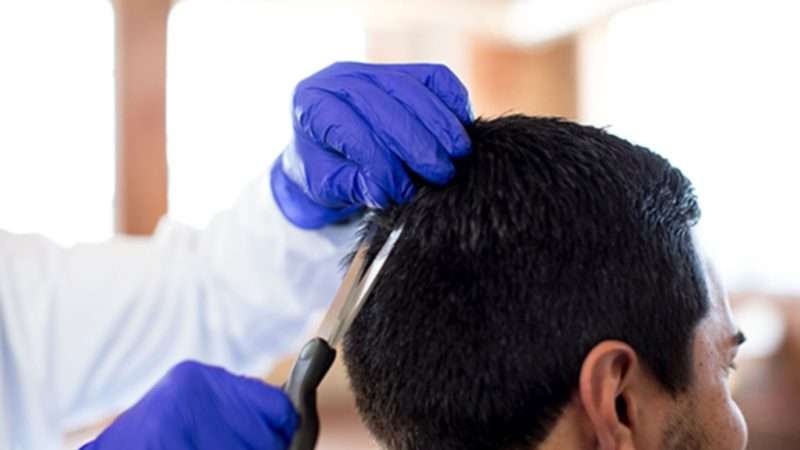
When 46-year-old Holly Barlow-Austin was detained in the Bi-State Justice Center jail on a probation violation on April 5, 2019, her vital signs were normal. Barlow-Austin was HIV-positive and suffered from bipolar disorder. Nevertheless, her white blood cell count and blood pressure were in healthy ranges when she was admitted to the jail, which sits on the border of Texas and Arkansas, a region known as Texarkana. The morning after she was incarcerated, her blood pressure was 118/73. She had no problematic vital signs.
Three days later, her husband went to the jail personally to hand over her medications, which were correctly labeled and showed up-to-date prescriptions. They included pills to manage HIV, depression, and bipolar disorder, as well as an antifungal. But jail staff initially withheld some medications and only gave her others sporadically, in a way that undermined their efficacy, according to a lawsuit filed Wednesday.
Soon after, she became seriously ill, complaining of a headache and a lump on her neck. Her blood pressure clocked in at higher than usual and she was placed in a medical observation cell in the jail.
Blood work performed by the medical staff at the jail on April 14 showed her white cell blood count at 87. The normal range in healthy adults is 500 to 1,500. Disturbing video footage shared with Reason by her family’s lawyer shows Barlow-Austin splayed on the ground of her cell, clutching her head. On April 30, she told jail staff her legs were numb. She was taken to the jail medical office, where they gave her Tylenol before returning her to her cell. Jail staff brought her to an outside mental health provider, who relayed the information to jail staff that Barlow-Austin had been fainting. In response, according to the lawsuit, a nurse on staff said that Barlow-Austin “pretends to be weak” and “knows how to play the sickly role.”
***
The Texarkana jail is operated by LaSalle Corrections, a private company that administers jails and immigration detention centers throughout the country. This week, the firm was in the news after a whistleblower claimed that another facility run by the company has failed to follow standard protocol to guard detainees and employees from the spread of COVID-19. “They’re still not taking this seriously,” nurse Dawn Wooten told The Intercept about the immigration detention facility in Georgia. “Enough was enough.”
Wooten also claimed that the detention center performed a staggering number of hysterectomies on immigrant women, Vice reported. “When I met all these women who had had surgeries, I thought this was like an experimental concentration camp,” a source told Vice. She said she’d met five women who’d received hysterectomies after being detained between October and December 2019. “It was like they’re experimenting with their bodies,” she said.
Previously LaSalle Corrections had been in the news after 20-year-old Morgan Angerbauer died of ketoacidosis, a condition which results from high blood sugar, while in custody at the Bi-State jail in 2016. She was denied medication to adequately manage her diabetes. Her pleas for help were ignored by staff despite the fact that she was unable to stand and was vomiting for hours, according to a lawsuit reported by the Texarkana Gazette. Lawyers for Angerbauer’s family eventually reached a settlement in a wrongful death suit with LaSalle.
In 2015, 35-year-old Michael Sabbie, who suffered from diabetes, asthma, and hypertension, told guards at the Bi-State jail that he couldn’t breathe. Guards reported him for “creating a disturbance” by “feining [sic] illness and difficulty breathing,” HuffPost reported. Guards threw him on the ground and pepper-sprayed him. He was found dead the next morning. A federal magistrate judge found the facility guilty of extreme medical neglect. “Here, the evidence shows that at various times during his confinement, the security officers knew Mr. Sabbie faced obvious health risks,” Judge Caroline Craven wrote. “She said there is sufficient evidence that several staffers ‘knowingly disregarded Mr. Sabbie’s complaints, thus acting with deliberate indifference to his serious medical needs.'”
LaSalle did not immediately respond to requests for comment for this story.
***
By May 2, 2019, Barlow-Austin’s blood pressure had climbed to 160/90. Staff found that she had a urinary tract infection. She complained to jail staff about headaches, vomiting, and blurred vision. She reported fainting frequently. She was not taken to a hospital.
By June, the lawsuit alleges, Barlow-Austin was blind as a result of her various undertreated conditions. Video shows her in distress, emaciated, flailing around on the floor of her jail cell, repeatedly soiling herself. Video shows a staff member setting a styrofoam cup of water in her cell on June 10, then falling back and holding their nose at the smell emanating from the cell. It was only the second cup of water she’d consumed in 16 hours, according to the complaint. In the video captured the same day, she appears to mouth “Help me” to two female inmates who’d been sent to her cell to clean it up.
During this period, her husband and family were repeatedly told she didn’t want to see them, when in fact she appeared to be unaware she had visitors and unable to communicate her desires.
On June 11, Barlow-Austin stopped moving. Two hours later, jail staff called 911. Her husband once again tried to visit her at the jail, on June 15, only to be told she was no longer there. It took days for him to figure out that she had finally been transferred to the hospital.
On June 17, she was dead. Cause of death was listed as fungemia/sepsis due to fungus, cryptococcal meningitis, HIV/AIDS, and accelerated hypertension.
Barlow-Austin was in the Bi-State Justice Center jail in part because, according to her family, she had decided to get help after years of struggling with drug addiction. They say she had violated the terms of her probation for a misdemeanor by deactivating her ankle bracelet and traveling to a rehab facility in nearby Dallas, and that she was jailed upon her return home—hardly an offense that should be punishable by death. Since the jail had technically released her to a hospital prior to her death, there was no formal criminal investigation into the case.
Erik Heipt, a civil rights attorney who handles police and jail brutality cases, is litigating the case. He tells Reason that he’s not easily disturbed. “I’ve handled many grotesque cases. I am not easily rattled,” he says. But the negligence in this case got to him. “What happened to Holly Barlow-Austin was cruel and inhumane. It was beyond all bounds of human decency,” Heipt says. “It was tantamount to torture. If a prisoner of war were treated this way, it would be a war crime.”
from Latest – Reason.com https://ift.tt/3iHszPW
via IFTTT


